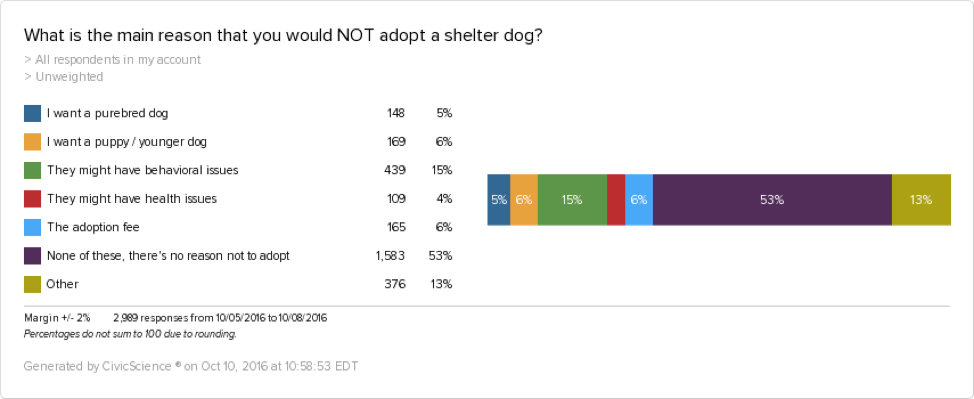Among other obscure monthly holidays, October is National Adopt a Shelter Dog Month. Yes, an entire month devoted to dog shelters, and the rescue of animals in need. Count me in. 3.7 Million dogs enter U.S. shelters each year, and of those, 1.2 Million are euthanized, and 1.4 Million are adopted. The reasons why these animals are surrendered varies, with the most popular reason being surrender due to housing situations, followed by those who just do not have enough time to care for their fluffy family members.
Although adoption is becoming more popular, there is still a lot of work to be done. There are still many concerns, hesitations, and doubts that lead people away from animal shelters. We looked into adoption preferences in the U.S in order to help shelters better understand who they still have to win over, and how to best reach them.
Between the two questions that we asked, we discovered valuable insights about where people would prefer to get a dog and why, as well as the most popular adoption hesitations, and ways to alleviate them.
Let’s start here – Adopt or Shop?
51% of people are more likely to adopt a dog from a shelter. The next biggest group includes those who would buy from a breeder, tied with those who are not sure whether they would adopt or buy. I personally found it refreshing to see that only 2% of people we asked would buy from a pet store. 10, or even 5 years ago, that number would surely be much higher.
Next, we asked:
Besides for those who see no reason not to adopt, and those who answered that they don’t like dogs, the biggest concern regarding adoption seems to be that shelter dogs might have behavioral issues (15%). This group is followed by those who answered “Other” (12%) and next, by the potential owners who want a puppy / younger dog (6%) or are concerned with the adoption fee (6%).
Let’s put some faces behind these hesitations.
Shelter Dogs Might Have Behavioral Issues
This group represents the largest portion of those with some concern with adopting a shelter dog. These folks are more likely to be college grads and employed. Geographically, they are more likely to live in the U.S. Northeast. As for food preferences, they are likely to eat most often at fast casual restaurants, and to be regular coffee drinkers.
This group is split between those who would buy a dog and those who would adopt. 44% would buy a dog and 42% would adopt despite their hesitations about behavior. 14% are not sure.
For the undecided 14%, the demographics above may provide opportunities to reach them, and alleviate their concerns about behavioral issues in shelter dogs. Particularly, advertisements and partnerships with fast casual restaurants, either local or nationwide, may provide a useful opportunity to meet them where they already are.
We also found that 63% of those who most worry about behavioral issues donate annually to religious non-profits, which is more than other hesitant groups. So, emphasizing adoption as a religious value of kindness towards animals, one that is present in many religions, may resonate as well.
Dog Shelters Don’t Have Puppies
The next largest reason why people would not adopt is that they want a puppy or younger dog. It is a common misconception that shelter animals are older, as there are many puppies that enter shelters each year. There are major benefits to adopting an older dog, as well. To take a look at these adoptable puppies, you need only explore the wonderful world of Petfinder.com.
We found that this group is more likely to be between 18 and 34 years old, to live with their parents, and that 69% of them are men. With this young age comes accompanying social media habits. They are more likely to use Snapchat, and Instagram as well.
We also found that only 22% of this group is likely to adopt, while 52% are likely to buy. A further 26% do not know. Lastly, this group is the most likely out of all other groups to buy a dog from a pet store. These tips may steer them away.
Their social media use presents an opportunity. Engagement through social media can be done with very little budget – a factor that is of major concern to most non-profit animal shelters. Creating an Instagram page, where shelters post photos and stories of their young and old dogs alike, may engage this group in previously untapped ways. For some inspiration from other animal shelters on Instagram, check out this site. Instagram presents infinite possibilities to show off those adorable shelter friends to the social media-savvy.
Lastly, 58% of this group most resonates with funny commercials, so illustrating the stories of shelter dogs in comical ways may further engage them.
Dog Shelters Have High Adoption Fees
The next biggest concern is the adoption fee. This fee usually rests around a few hundred dollars, and covers certain medical procedures such as spaying/neutering, and microchipping. As you may guess, those who are deterred by the adoption fee are more likely to be unemployed, earn under $50k a year, and be price-conscious. They are also more likely to live in a rural area.
Interestingly, 10% of this group is likely to buy a dog from somewhere other than a breeder or pet store. Perhaps they are likely to get one for free from an accidental dog litter. If shelters hope to win over this group, they may have to convince them why the adoption fee is worth it.
On the other hand, cutting the cost of the adoption fee is not always a possible or desired option. Each individual shelter will have to take this into account.
There Are No Purebred Dogs in Dog Shelters
Although they make up a relatively small percentage of the reasons people would not adopt, those who want a purebred dog may be the hardest to win over. 78% of them are likely to buy a dog, and only 9% of them answered that they don’t know if they would adopt or buy. To convince them of adoption, shelters will have to find a way to show that there are, in fact, many purebred dogs in shelters. To be exact, it’s estimated that 25% of shelter dogs are purebred. On the other hand, shelters may want to educate this group on why mutts make just as loveable companions.
We uncovered a few insights that may help shelters accomplish this.
First, we found that these folks are more likely to earn over $100k a year, and consequentially, are more likely to dine regularly at upscale restaurants. They are also more likely to drink Brown Spirits regularly, and are more likely to be men.
They are also tech-savvy. They are more likely to own or want a smart watch. The same goes with an augmented reality product.
In terms of their media preferences, they are more likely to choose music based on social media influence, and they are more likely to actively use Instagram. They are also more likely to be fans of reality TV, and are less likely to be fans of TV dramas.
What all of this says to me is that they want to be along with, or ahead of the times. They want to do the “cool” thing. They want the newest products and they want to listen to what their friends do. To convince them of adoption, shelters may want to re-frame adopting as the “cool thing to do” for those who are able. Some websites have social media links where you can see friends who have shopped or reviewed there. Maybe there is a way to work this concept into shelters by showing potential dog owners who else they know that has adopted.
Maybe this could take the form of a campaign, encouraging past adopters to take pictures, and share stories of their furry friends. If other people do it, they might as well. Additionally, with their high-income and leisurely lifestyle, they may be able to offer shelter dogs luxuries and amenities that they deserve, but may be unable to receive otherwise.
Shelter Dogs Might Have Health Issues
Only 4% of people cited this as an adoption concern, which I personally would have expected to be higher. Most prominently, we found that these folks are more likely to earn under $50k a year.
Anyone who has had a dog knows that veterinary bills can be bone-breaking, especially for those who have a lower income. This group may be especially concerned with health issues because of the costs they accompany. In order to alleviate these concerns, shelters will have to show that shelter dogs do not have health issues. In fact, they tend to have fewer health problems than those bought from a breeder or pet store.
The Adopters
The largest group by far! 51% of people answered that they are likely to adopt a dog from a shelter, and 53% answered that there is no reason not to adopt.
These folks are more likely to be women, and are less likely to live in the U.S. Northeast. They are more likely to donate to environmental and educational charities, and lastly, they are more likely to choose TV shows and movies based on social media influence.
Given that they are likely to be influenced by social media, perhaps we can assume that they have some influence on social media as well. Therefore, tapping into this group to influence others, and to alleviate the primary adoptions concerns listed above, may help to win others over.
Mission Im-PAWS-ible
As a very happy past-adopter, I can say with a certain degree of certainty, for whatever it’s worth, that adopting a dog is one of the most beautiful and satisfying things that I’ve ever done. For the most part, these dogs are loving, healthy, and incredible to spend time with. Their main distinction is that their previous homes didn’t work out, but that doesn’t mean their future homes won’t. Many have speculated that with their history of situations that are less-than-pleasant, they are even more grateful for a kind and loving home. They provide an incredibly unique sense of unconditional love.
We hope that these insights that will make it easier for animals shelters to understand those who will adopt and those who will shop, so that they can more effectively find forever homes for their furry friends.











